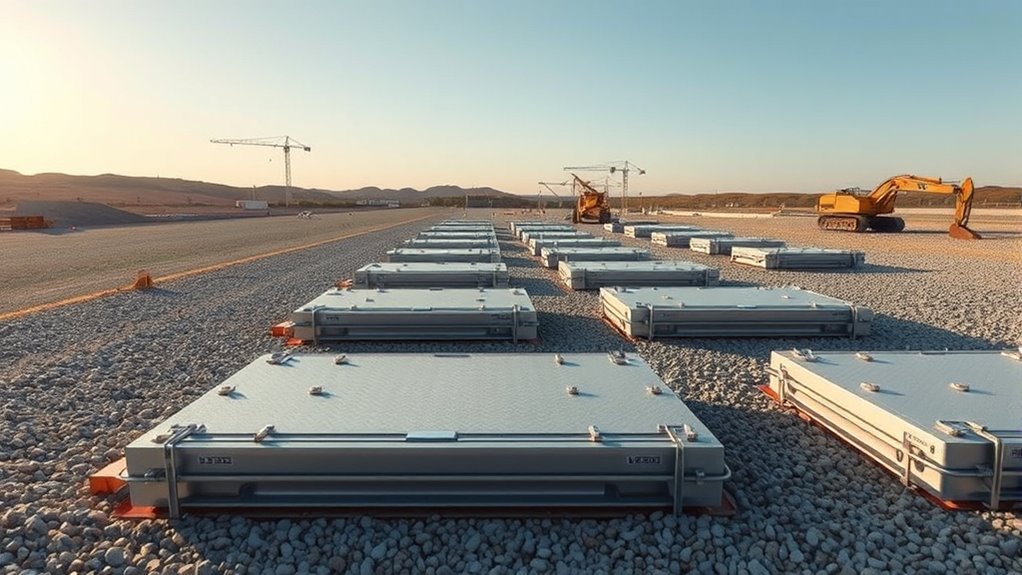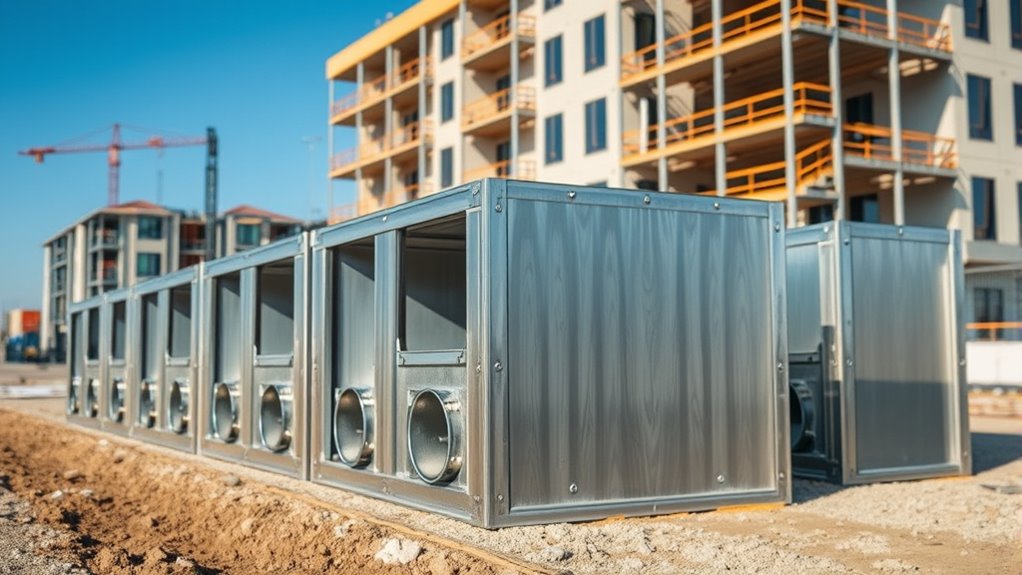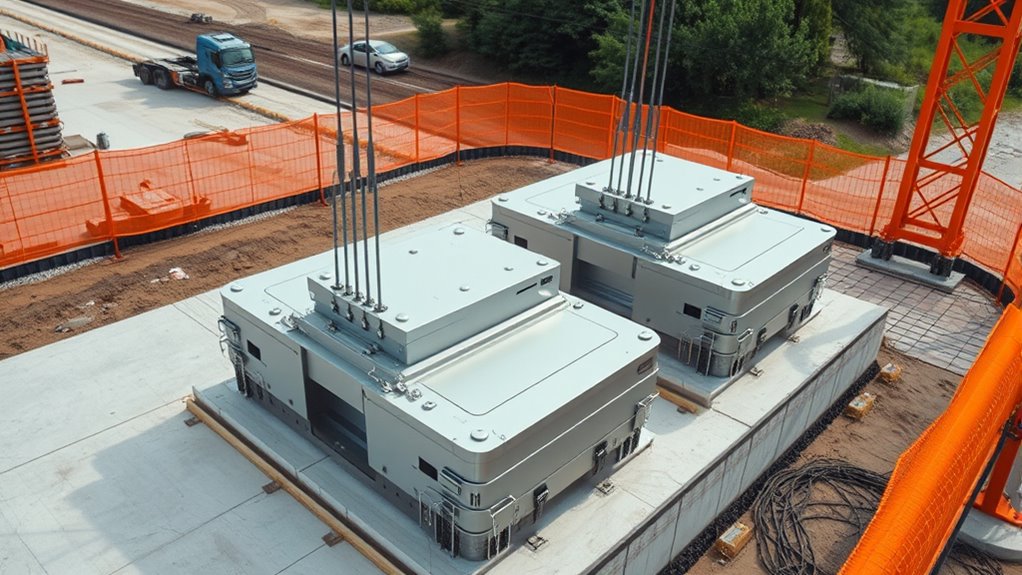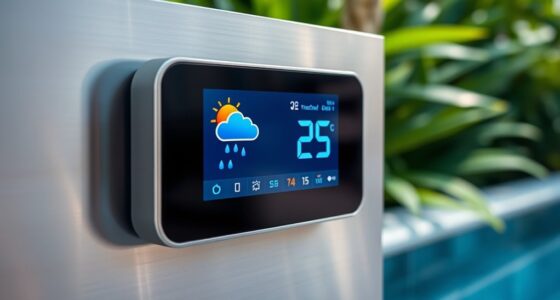Modular mechanical rooms with prefab pads offer a fast, reliable way to install complex building systems. These drop-in units are designed for quick placement, reducing on-site labor and construction time. They feature durable materials, integrated utility connections, and precise fabrication for easy integration. This approach minimizes disruptions and guarantees consistent reliability. If you want to discover how these solutions can streamline your project and save costs, keep exploring for more insights.
Key Takeaways
- Prefab pads are pre-engineered, modular platforms designed for quick installation of mechanical room components.
- They facilitate faster building setup by reducing on-site construction time and minimizing disruptions.
- Modular designs ensure precise fit, structural integrity, and seamless integration with building systems.
- Integrated utility connections simplify linking power, water, and gas, enhancing system reliability and maintenance.
- Prefab pads support scalable, adaptable mechanical rooms ideal for renovation, expansion, or new construction projects.
Advantages of Modular Mechanical Rooms in Modern Construction

Modular mechanical rooms offer significant benefits in modern construction by streamlining the building process and reducing on-site labor. When you choose prefab pads, you cut down on the time needed to install complex systems, allowing your project to move faster. Prefabricated units are built in controlled environments, ensuring higher quality and fewer errors compared to traditional on-site construction. This approach minimizes disruptions on your site, leading to less waste and fewer safety concerns. Additionally, modular rooms enable easier scheduling and coordination, as components arrive ready for quick installation. You benefit from predictable costs and reduced labor expenses, making the project more cost-effective. Overall, modular mechanical rooms provide a smarter, more efficient way to meet the demands of modern construction projects.
Key Components and Design Features of Prefab Pads

When designing prefab pads, you focus on ensuring strong structural integrity with durable materials that withstand environmental stresses. You also need to plan for integrated utility connections, making installation seamless and efficient. By paying attention to these key components, you can create a reliable foundation for your modular mechanical room. Additionally, selecting high-quality materials ensures longevity and reduces maintenance needs over time.
Structural Integrity and Materials
The structural integrity of prefab pads relies on carefully selected materials and robust design features that guarantee durability and stability. You’ll want high-strength concrete or steel reinforcement to withstand weight loads and environmental stresses. The base layer is typically reinforced with rebar or wire mesh, ensuring it resists cracking and shifting over time. Insulation panels or vapor barriers are integrated to protect against moisture infiltration and temperature fluctuations, which can compromise structural stability. Precise fabrication techniques ensure consistent dimensions and alignment, reducing installation errors. Additionally, the pad’s design includes load distribution features that evenly spread weight across the foundation. These choices in materials and design not only enhance longevity but also assure the pad remains stable under varying operational conditions. Proper understanding of structural safety principles is essential for ensuring the overall performance of the prefab pad.
Integrated Utility Connections
Integrated utility connections are essential components that streamline the setup and operation of prefab mechanical rooms. These connections allow you to quickly link power, water, gas, and other systems directly to the room without custom on-site modifications. Designed for efficiency, they come with pre-installed ports and flexible fittings, reducing installation time and minimizing errors. You’ll find that these connections are often labeled and organized for easy access, helping maintenance and future upgrades. The integration ensures a tight seal and reliable performance, preventing leaks or disconnections. Proper installation practices are crucial to ensure these connections function optimally over time. With these features, you can expect faster project completion and improved system reliability. Overall, integrated utility connections simplify the building process and enhance the functionality of your modular mechanical room.
The Installation Process: From Delivery to Deployment

Once the modular mechanical room arrives on-site, the focus shifts to efficient installation and setup. You begin by carefully positioning the prefabricated unit onto a prepared foundation or pad, ensuring it aligns properly with existing utility connections. Using cranes or forklifts, the module is gently lowered into place, reducing on-site construction time markedly. Next, you connect the utility hookups—water, electrical, and HVAC—using pre-installed ports, which streamlines the process. Once all connections are secured, you perform a thorough inspection to verify everything is correctly installed and functioning. Proper system testing is essential to confirm operational performance and identify any issues early. Finally, you power up the system, conduct operational testing, and make any necessary adjustments. This streamlined approach minimizes disruptions, accelerates deployment, and guarantees a smooth shift from delivery to operational readiness.
Cost and Time Savings With Prefabricated Solutions

Prefabricated solutions can markedly cut your construction time, allowing projects to move forward faster. This streamlined approach also helps reduce overall expenses by minimizing on-site labor and material waste. As a result, you save both time and money without sacrificing quality or safety. Incorporating daily goal tracking into project management can further enhance efficiency and accountability throughout the construction process.
Reduced Construction Duration
Have you ever wondered how modular mechanical rooms can considerably cut construction time? The answer lies in their streamlined assembly process. First, prefabricated components are built off-site, reducing on-site labor and delays. Second, these modules arrive ready to install, saving time compared to traditional construction. Third, the quick drop-in installation minimizes disruptions to ongoing site activities. Fourth, fewer on-site workers and less weather dependency lead to faster project completion. As a result, you’ll see a significant reduction in overall project duration, enabling earlier system operation and faster project turnover. This efficiency not only accelerates timelines but also helps you stay within budget by minimizing labor costs and scheduling setbacks. Modular solutions truly transform how fast you can get your mechanical systems up and running.
Lower Overall Expenses
Opting for modular mechanical rooms can substantially reduce your overall expenses by cutting both construction costs and time. Prefabricated solutions minimize on-site labor, reducing labor costs and delays caused by weather or unforeseen issues. Since modules are built in controlled factory environments, quality control is easier, leading to fewer rework and maintenance expenses later. The speed of installation means your project moves faster, saving you money on site supervision and rental equipment. Additionally, modular rooms often require less foundation work, further lowering costs. These savings don’t come at the expense of quality; they enhance efficiency and predictability. Implementing modular solutions also fosters better trust-building activities between project stakeholders by promoting transparency and collaboration. Overall, choosing prefab pads for your mechanical needs ensures you stay within budget while accelerating project timelines, giving you a more cost-effective, streamlined solution.
Flexibility and Scalability for Various Building Types

How can modular mechanical rooms adapt to the diverse needs of different building types? The answer lies in their inherent flexibility and scalability. First, you can customize sizes to fit small offices or large commercial complexes. Second, you can select from various configurations to accommodate specific equipment or systems. Third, modular rooms can be expanded easily as your building’s needs grow, avoiding costly overhauls. Fourth, they’re quick to install, minimizing disruptions during construction or renovation. This adaptability means you get a solution tailored precisely to your building’s requirements, whether it’s a hospital, school, or retail space. Additionally, understanding the shelf life of components and proper storage can ensure the longevity and optimal performance of your modular mechanical rooms. Modular mechanical rooms offer a versatile approach that evolves with your project, ensuring efficient operations without compromising on space or performance.
Future Trends and Innovations in Modular Mechanical Systems

As technology advances, modular mechanical systems are poised to become even more intelligent and interconnected. Expect smarter components that communicate seamlessly, enabling real-time monitoring and predictive maintenance. This connectivity will streamline operations, reduce downtime, and optimize energy use. Innovations like integrated IoT sensors will provide instant data insights, allowing you to adjust systems proactively. Additionally, automation will play a bigger role, with systems self-adjusting based on environmental changes or occupancy patterns. Modular designs will incorporate advanced materials for enhanced durability and efficiency. Prefabricated units will evolve to include more integrated functions, reducing installation time further. The integration of smart components will further enhance system responsiveness and adaptability. These trends promise to make mechanical rooms more efficient, adaptable, and easier to maintain, helping you stay ahead in building management and sustainability efforts.
Frequently Asked Questions
How Do Modular Mechanical Rooms Impact Building Maintenance Routines?
Modular mechanical rooms simplify your building maintenance routines by allowing quicker access and easier upgrades. They’re pre-fabricated, so you spend less time on installation and repairs. With their standardized design, you can quickly identify issues and perform routine inspections. Plus, modular rooms reduce downtime, making maintenance more efficient. Overall, they help you keep your building running smoothly, saving time and reducing costs on upkeep.
What Are the Environmental Benefits of Using Prefab Pads?
Using prefab pads is like planting a green seed for the environment. They reduce construction waste by minimizing on-site building, lowering landfill contributions. Prefab pads also cut down on energy use during manufacturing and transportation, decreasing your carbon footprint. Plus, they often feature sustainable materials, helping you support eco-friendly practices. Embracing prefab pads helps you build smarter and greener, making a positive impact on the planet while streamlining your construction process.
Can Modular Systems Integrate With Existing Building Infrastructure?
Yes, modular systems can seamlessly integrate with your existing building infrastructure. You just need to plan the connection points carefully, ensuring compatibility with current utilities and structural elements. This approach minimizes disruption, speeds up installation, and allows for future upgrades. You’ll find that modular systems adapt well, providing flexibility to expand or modify your building’s mechanical capacity without extensive renovations.
What Are the Limitations of Modular Mechanical Room Applications?
Like a ship steering treacherous waters, you may find modular mechanical rooms face limitations such as size constraints, making it difficult to accommodate complex systems. They might not always fit seamlessly into existing structures, requiring additional modifications. Also, customization options can be limited, which could restrict your ability to tailor solutions precisely to your project’s unique needs. Recognizing these boundaries helps you plan more effectively and avoid unexpected setbacks.
How Do Modular Pads Affect Long-Term Building Energy Efficiency?
Modular pads can improve your building’s long-term energy efficiency by providing a stable, well-insulated foundation for mechanical equipment. They reduce energy loss through better thermal performance and minimize vibrations that can affect equipment operation. Additionally, their precise installation helps guarantee systems run smoothly, saving you energy and maintenance costs over time. Overall, using modular pads supports a more efficient, sustainable building operation, lowering your energy expenses and environmental impact.
Conclusion
You might worry that modular mechanical rooms lack customization, but they actually offer flexible design options tailored to your project’s needs. By choosing prefab pads, you save time and reduce costs without sacrificing quality or functionality. This scalable solution adapts easily to different building types, ensuring you get a reliable, efficient system. Embracing modular technology means you can streamline construction and stay ahead in modern building practices—so don’t let initial doubts hold you back.









